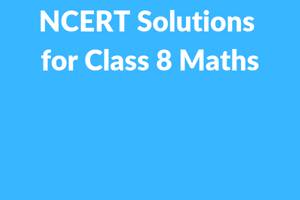Maths is not that “difficult” subject as it is often presumed to be. It is just based on logical,...
8th Class Maths – A Quick Overview
Exams are the most stressful times in a student’s life, and students often tend to panic with stress and pressure when it comes to mathematics. However, no exam and deadlines can get you over-stressed when we follow the right strategy and path to preparations. Here, we will be discussing some of these strategies that would help 8th class maths students to prepare for their exams. 8th standard is one of the transient phases in a student’s school life when they are slowly entering into the world of senior education. Therefore, 8th class maths exams can bring more pressure or fear for the students who already fear the name of mathematics. Worry not; with a guided approach and Kapdec’s resourceful maths e-learning portal, everyone can sail through it easily. Let’s begin by understanding the 8th class maths syllabus. to
Blog Contents
8th class maths – an important stepping stone
It is well understood that each class lays some important foundational concepts for higher studies. 8th standard is one such important stepping stone where students learn many new and crucial concepts and lessons that will be of great use in their further studies. Because of this, parents and teachers tend to pressure the students to pay more attention and get more serious about their studies. Therefore, let us closely look at some important concepts in the class 8 maths syllabus.
The 8th class maths book, as per the CBSE syllabus, consists of 16 chapters. These are:
- Rational Numbers
- Linear Equations in One Variable
- Understanding Quadrilaterals
- Practical Geometry
- Data Handling
- Squares and Square Roots
- Cubes and Cube Roots
- Comparing Quantities
- Algebraic Expressions and Identities
- Visualizing Solid Shapes
- Mensuration
- Exponents and Powers
- Direct and Inverse Proportions
- Factorization
- Introduction to Graphs
- Playing with Numbers
Each of these chapters takes students through different concepts and theories that are the foundation of mathematics. Some of these are in continuation to the maths syllabus in previous classes. Therefore, students can here understand how maths is interconnected and linked. Now, let’s look at some of the important concepts that these 16 chapters cover in the NCERT 8th class maths book.
The topics covered in chapter 1, Rational numbers, are Properties of Rational Numbers, Commutativity, Associativity, Negative of a number, Reciprocal, Distributivity of multiplication over addition for rational numbers, Representation of Rational Numbers on the Number Line, and Rational Numbers between Two Rational Numbers.
The topics covered in chapter 2, Linear Equations in One Variable, are Solving Equations with Linear Expressions on one Side and Numbers on the Other Side, Solving Equations having the Variable on Both Sides, Applications, Reducing Equations to Simpler Form, and Equations Reducible to the Linear Form.
The topics covered in chapter 3, Understanding Quadrilaterals are Polygons, Sum of the Measures of the Exterior Angles of a Polygon, Kinds of Quadrilaterals, Parallelogram, and rectangle.
The topics covered in chapter 4, Practical Geometry, include Constructing a Quadrilateral When two diagonals and three sides are given and discussing some special cases.
The topics covered in chapter 5, Data Handling, are Looking for Information, Organising Data, Grouping Data, Circle Graph or Pie Chart, and Chance and Probability.
The topics covered in chapter 6, Squares and Square Roots, are Properties of Square Numbers, Finding the Square of a Number, Pythagorean triplets, Square Roots, Finding square root through prime factorization, Square Roots of Decimals, and Estimating Square Root.
The topics covered in chapter 7, Cubes and Cube Roots, are simple as its name. It talks about how to find cubes and cube roots of various numbers and integers.
The topics covered in chapter 8, Comparing Quantities, are Ratios and Percentages, Finding the Increase or Decrease percent, Finding Discounts, Prices Related to Buying and Selling (Profit and Loss), Sales Tax/Value Added Tax/Goods and Services Tax, Compound Interest, Deducing a Formula for Compound Interest, Rate Compounded Annually or Half Yearly (Semi-Annually), and Applications of Compound Interest Formula.
8th class maths algebra – an important concept
The topics in all 16 chapters are vast. However, one of the main topics in ‘8th class maths’ is algebra. It also constitutes the main part of the ‘class 8 maths question paper’. Algebraic Expressions and Identities is the 9th chapter in the 8th class maths book but is also present in other topics in the entire syllabus.
‘8th standard maths algebra’ introduces students to more complex algebraic problems. It helps students learn certain tricks and formulas or algebraic identities that will come in handy while solving algebraic problems in higher classes. Algebra is a significant branch of mathematics in which quantities and numbers are represented by generic symbols and characters in equations and formulas. Those sections of algebra that include the most fundamental concepts are known as elementary algebra, whereas the more abstract parts are referred to as contemporary algebra or abstract algebra. For example, rings, groups, and fields are all addressed in Algebra, which encompasses anything from solving basic equations to studying complex concepts.
There are eight main algebraic identities in 8th standard maths algebra:
- (a+b)2 = a2 + 2ab + b2
- (a-b)2 = a2– 2ab+b2
- (x+a) (x+b) = x2+(a+b) x+ab
- (a+b+c)2= a2+b2+c2+ 2ab+2bc+2ca
- (a+b)3= a3+b3+3ab(a+b)
- (a-b)3= a3 -b3-3ab(a-b)
- a3 +b3+c3-3abc
- a2-b2= (a+b) (a-b)
Some quick tips to prepare for exams
The secret key to excelling in 8th standard maths algebra and other chapters is practice. The more you practice, the more you will be aware of the tricks and methods to solve different questions. Also, only practice can help you get a good grip of your knowledge and intelligence when it comes to maths. Solve various mock ‘maths questions for class 8′. Keep a tab on time while you solve these to help you map your progress.
Make a list of all key ideas and formulas for rapid reference and review as your first step. Using a chapter list ensures that you don’t miss any key topics and review each subtopic and subject quickly. You may also recollect concepts by simply looking at these notes.
Attempt to solve as many previous year’s question papers as possible to learn which questions were asked and how many marks were given to each question. In addition, it offers a sense of how long a response should be. By solving the previous year’s class 8 maths question paper, you may also understand how many different ways the same question has been asked and answered.
Handling pressure – a note to students, teachers, and parents
Whether mathematics or any other subject, class 8th is an important phase in a student’s life when they are slowly learning to develop more concentration and seriousness towards their studies. However, all this needs to be taken in a very healthy manner.
Here, we recall a famous saying that the pressure that can turn coal into a diamond can break something causing irreversible damage. By stating this here, we wish to assert that the right amount of pressure at the right time can help you develop the best version of yourself. In other words, pressure is not always bad, as long as it respects your capabilities. Therefore, parents and teachers must help students in the best ways that they can. Over-pressurizing them at the wrong times would break the kids’ confidence and motivation. While appreciating them for their little efforts and then giving them the next goals will help them flourish to the best of their capabilities.
On the other hand, students must also set realistic targets for their class 8 maths and other exams. Comparing their progress and achievements with others would only bring distractions from their main point of study. Take as much as you can and put in your best efforts. As long as you are satisfied with the time and efforts you have put in, your results are the best to deserve all the applause. This does not only apply to the 8th standard but for all the students right from class 1st to 12th and even to those pursuing higher education.
Summing it up, we can infer three main points. First, “8th standard” and “class 8 maths”, in particular, are important stepping stones in any student’s academic journey. It teaches you many important lessons that will be carried forward and of great use in future studies and other endeavors. Secondly, this is when a student is developing into the best version of themselves, and therefore, the right guidance and approach can produce wondrous results. Thirdly, practice and consistency take you a long way. If you are afraid of any particular subject, say maths, practice as many “class 8 maths question papers” as possible. Follow Read, re-read, learn and relearn strategy till you are confident about the subject, and never hesitate to ask for help from your teachers, parents, and friends. Lastly, compete, but only for improving! Remember, there’s a fine line between healthy and unhealthy competition is a core value that sets the leaders apart!
.png?width=100&height=100&name=Kapdec%20Logo%20(400px).png)


